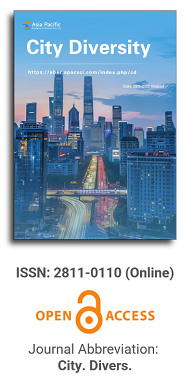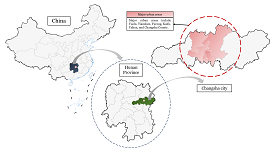
Asia Pacific Academy of Science Pte. Ltd. (APACSCI) specializes in international journal publishing. APACSCI adopts the open access publishing model and provides an important communication bridge for academic groups whose interest fields include engineering, technology, medicine, computer, mathematics, agriculture and forestry, and environment.

As China's pillar industry, the property market has suffered a considerable impact in recent years, with a decline in turnover and many developers at risk of bankruptcy. As one of the most concerned factors for stakeholders, housing prices need to be predicted more objectively and accurately to minimize decision-making errors by developers and consumers. Many prediction models in recent years have been unfriendly to consumers due to technical difficulties, high data demand, and varying factors affecting house prices in different regions. A uniform model across the country cannot capture local differences accurately, so this study compares and analyses the fitting effects of multiple machine learning models using February 2024 new building data in Changsha as an example, aiming to provide consumers with a simple and practical reference for prediction methods. The modeling exploration applies several regression techniques based on machine learning algorithms, such as Stepwise regression, Robust regression, Lasso regression, Ridge regression, Ordinary Least Squares (OLS) regression, Extreme Gradient Boosted regression (XGBoost), and Random Forest (RF) regression. These algorithms are used to construct forecasting models, and the best-performing model is selected by conducting a comparative analysis of the forecasting errors obtained between these models. The research found that machine learning is a practical approach to property price prediction, with least squares regression and Lasso regression providing relatively more convincing results.
Issue release: 31 December 2022
In the context of the new era, people's pursuit of a better life is becoming more and more prominent. The diversity and welfare of urban services will become an important support for attracting labor and optimizing talent structure. This paper uses the "meituan.com" life service classification and the 2017 China floating population dynamic monitoring survey (CMDS) data to study the impact of urban service diversity on labor mobility. The results show that the diversity of urban services will significantly reduce the willingness of migrant population to move out. For every 1% increase in the diversity of service categories, the average probability of labor migration will be reduced by about 3.5% 23%; The impact of urban service diversity has group differences. Younger and highly skilled groups are more sensitive, and the marginal effect can reach 4.5% 62% and 4 03%. Considering the adjustment effect and regional heterogeneity, the expansion analysis further found that the level of urban informatization and marketization has a positive amplification effect on the diversity of service categories to attract and retain talents, especially in the eastern region and large cities with a population of more than 5 million. This study provides policy enlightenment for urban talent attraction and labor competition.
Issue release: 31 December 2022
Using the commercial housing price data of 254 cities at prefecture level and above in China, this paper measures the cultural diversity by the diversity of Chinese dialects, and studies the impact of regional culture represented by dialects on urban housing prices. The research shows that after controlling the economic development level of the city, the urban ecological environment and other factors, the cultural diversity measured by dialect types has a significant negative impact on the price of urban commercial housing, that is, the more diverse the culture, the lower the house price, and the cultural diversity will restrain the house price by hindering the inflow of local population.
Issue release: 31 December 2022
The habitat quality and connectivity structure of urban small and medium-sized green space play an important role in promoting urban biodiversity. Under the influence of community life circle services, the urban green space construction in China has formed a typical and repetitive green space pattern. Exploring the minimum quadrat of green space composition and its habitat elements and morphological structure is an important way to improve the urban ecological quality and green space planning and design. This research, based on the basic achievements of urban site habitat construction and ground cover plant community design in northwest China, takes the green space in the old and new urban areas of Xi’an City as the objects. It puts forward the basic scale quadrat of “2 km × 2 km” urban block green space habitat network by using the research paths of review, geographic information interpretation-field surveys and cluster analysis. It has found four typical patterns, which are single-core radiation, multi-core dispersion, corridor crossing and scattered distribution. It also analyzes the coupling relationship between the form, elements and spatial pattern of the quadrat, and explores the ways to improve the construction of green spatial habitat network in the quadrat system.
Issue release: 31 December 2022
Issue release: 31 December 2022
In order to further tap the ecological potential of urban trees, improve the diversity of tree species in urban environment, and promote the sustainable development of urban trees, this paper further analyzes the structure, diversity and spatial distribution law of the prominent tree species in Hefei city on the basis of on–the–spot identification of the prominent trees distributed in the main city. The results show that: 1) 528 significant trees are identified in the three districts, belonging to 40 species, 36 genera and 27 families, with 23 trees evaluated by qualitative index and 505 trees by quantitative index. In quantity distribution, the number of significant trees in the three districts is ranked as Yaohai District > firstringroad City > Government Affairs District. The top four tree species in relative abundance are Platanus acerifolia, Cinnamomum camphora, Ginkgo biloba and Cedar. 2) In terms of the tree age structure, most trees are 20~40 years old, and only 22 trees are over 100 years old; the ratio of evergreen to deciduous tree species is 1:3, and the ratio of plant to tree is about 7: 18; there are 23 native tree species accounting for 57.50%, but only 171 trees. 3) In terms of area distribution, the average tree height and crown area in Yaohai District are the largest, the average DBH, Shannon–Wiener index and Simpson index in the first–ring city area are the highest, and the species evenness index in Government District is the highest. 4) In terms of site types, most significant trees are distributed in urban streets, residential areas and parks, and only 11.74% of them are distributed in government organizations, schools, public facilities, scenic spots and religious land.
Issue release: 31 December 2022
With the rapid development of urbanization, the development and construction of new towns and new areas has become the main direction of urban expansion. On the contrary, the development of the old urban areas has been neglected and gradually fell into recession. In the new era, how to promote the new vitality of the old city and realize the double wheel drive between the old city and the new city has become an urgent research topic. Enning Road, located in the old urban area of Liwan, guangzhou, gathers the essence of Xiguan arcade building, but once became a typical example of the decline of old blocks. Through micro transformation, it not only protects the authenticity of the historical environment, but also promotes the development of the cultural tourism industry, realizes the regeneration of the historical and cultural blocks, and walks out a unique road to the revitalization of the historical and cultural blocks. Based on this analysis, the article puts forward policy suggestions to further improve the revitalization of historical and cultural blocks from the aspects of establishing a diversified participation mechanism, correctly handling the relationship between the protection and development of historical and cultural relics, and preventing violations of consumer rights and public interests.
Issue release: 31 December 2022
Modern urban governance emphasizes the precise governance of the “short board” of urban governance, forming a mechanism of fine governance. In view of the historical basis and realistic structure of the differentiation of physical space at the block level and the diversity of life at the community level in modern cities, the short board of urban governance should be confirmed and solved through democratic participation based on the context of spatial differentiation and diversity of life, rather than through simple administrative urban planning, so as to form a corresponding structure consistent with rigid urban management. The vitality of a city lies in the construction of differentiated block space and diversified community autonomy. Therefore, the urban path of fine governance is fine governance based on public recognition. It should include the establishment of the concept of spatial differentiation and diversity of life, the construction of democratic relations among modern urban governance subjects, the transformation of urban planning to community planning, and the avoidance of destructive renewal and one-way material construction, go beyond the sports regulation of urban issues and apply the big data technology in modern urban governance.
Issue release: 31 December 2022
As an important human-caused disturbance factor, urbanization has significantly changed the structure of natural habitats and influenced the composition of animal communities. The characterisitions of abundant population amount, high spcies diversity, and easy to be collected of ants make these species become excellent models for studying the effects of land-use types on the composition of animal communities in urban areas. In May 2018, ants were sampled from 3 land-use types (‘garden and greenland’, ‘dry farm’ and ‘woodland’) using pitfall traps in an urban area of Nanchong city, Sichuan province. A total of 1 847 ant individuals were collected. The proportion of Tetramorium tsushimae was the highest in ‘garden and greenland’ (73.80%), and significantly higher than that of Monomorium chinense in ‘dry farm’ (25.48%) and Pheidole nodus in ‘woodland’ (28.79%). There was no significant difference in the number of indiviuduals and species richness among the 3 habitats, but the Simpson diversity index and Pielou evenness index of ant community in the habitat of‘garden and greenland’were significantly lower than those in the habitats of‘dry farm’and‘woodland’; the composition of ant community in‘woodland’was moderately different from that in‘garden and greenland’(q = 0.444)and‘dry farm’(q = 0.500), and the community composition in‘garden and greenland’and‘dry farm’(q = 0.647)was moderately similar. Therefore, the compositions of ant communities are varied in different land-use types in urban areas, and the habitat of ‘garden and greenland’ is more likely to facilitate the formation of dominant species than ‘dry farm’ and ‘woodland’.

Prof. Mehmet Cetin
Kastamonu University,
Turkey
Polish Scientific Bibliography


 Open Access
Open Access